Putting Prestressed Masonry to Use
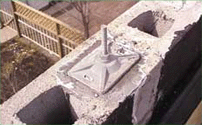 Prestressed masonry is not new. Some very industrious and creative builders used it back in the 1800s, although they did not call it prestressed masonry at that time. Since the 1980s and the advent of masonry research, the technology has developed and is now used throughout the world. While the British first adopted standards for prestressed masonry in 1985, the U.S. standards were introduced with the 1999 edition of the Masonry Standards Joint Committee code (MSJC).
Prestressed masonry is not new. Some very industrious and creative builders used it back in the 1800s, although they did not call it prestressed masonry at that time. Since the 1980s and the advent of masonry research, the technology has developed and is now used throughout the world. While the British first adopted standards for prestressed masonry in 1985, the U.S. standards were introduced with the 1999 edition of the Masonry Standards Joint Committee code (MSJC).
Simply stated, prestressing adds compression to masonry. For example, Figure 1 shows a single-wythe wall with a tendon. The tendon has anchors and bearing plates at the top and bottom. Once the masonry is constructed, the tendon is stressed which compresses the wall. Depending upon the actual design, there may be little or no grout used in the cores, which reduces time and money.
Why would we want to do this? Masonry is very strong in compression. Prestressed masonry compensates for any external forces (wind, earthquakes, earth pressure, etc.) that would normally cause the wall to bow and crack from tension by using masonry's strength under compression.
Is prestressing really new? Not really! Figure 2 is copied from the design drawings of a 1960s building with brick parapets. In the figure, the parapet is "clamped" down to the edge of the roof with an anchor rod and steel plate. The bottom of the rod is anchored into the roof slab. Masons know that tightening the rod effectively compresses the parapet wall and makes it more stable.
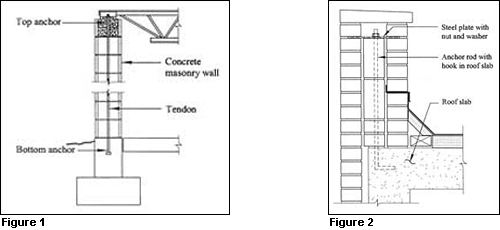
While we call it prestressed masonry, most applications use post-tensioning. This means the masonry is first constructed along with the tendons. The masonry is then partially cured and the tendons are tightened, thereby putting the masonry in compression. Pre-tensioning is another form of prestressed masonry whereby the tendons are first installed and tensioned and the masonry is built around the tendons. Once the masonry cures, the tendons are released and bond to the masonry, transferring the stress to the masonry similar to the way pre-cast concrete plank is stressed. This article will focus on post-tensioning.
Applications
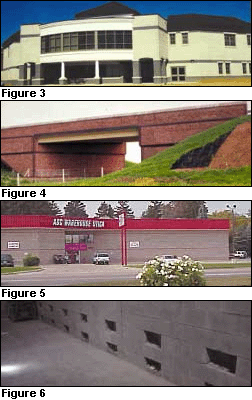 How does prestressed masonry get used in a project? On some projects, it will be a bid requirement based upon the design. However, on many projects, prestressing has been proposed by contractors as an option to lower costs.
How does prestressed masonry get used in a project? On some projects, it will be a bid requirement based upon the design. However, on many projects, prestressing has been proposed by contractors as an option to lower costs.
Compared to reinforced masonry, prestressing can speed up construction and save costs because there is less grout and mild reinforcement to be installed. However, the reduction in material costs of mild reinforcing is partially offset by more costly hardware. Prestressing also offers an alternative to other wall systems such as tilt-up walls for tall, slender walls.
Prestressing is not suited for every project, though; each project has to be evaluated on its own merits. Besides considering the economics, there can also be some code limitations ? U.S. codes currently limit prestressed masonry shear walls to low seismic areas.
While architects and engineers are still learning how to design with prestressing, contractors are also learning how to price and construct these walls. Learning to use prestressed masonry provides another method of construction to the contractor's list of abilities. As you will see, the techniques can be used in both new construction and for strengthening and repairing existing buildings.
For new work, prestressing is well-suited to walls of one- and two-story buildings. The systems are ideal for retail buildings, warehouse, offices, gymnasiums, schools and "tallwall" types of buildings. It has also been used for the fa?ade of parking structures. Figure 3 shows a new building that has been constructed using prestressing.
Over 15,000 houses in the southwest U.S. rely on prestressing using the Integra system, a concrete block that utilizes a special internal design to decrease heat penetration.
Figure 4 is a bridge in England; all of the retaining walls are brick reinforced with prestressing tendons.
The repair and strengthening market has taken to prestressing as well. For example, the walls in Figure 5 needed strengthening. As most of you know, masonry strengthening often involves cutting open a wall and inserting reinforcement and grout. Unlike traditional methods, these walls were strengthened with far less cutting and without the wall grout. Figure 6 shows the access ports at the bottom. An additional port was installed at mid-height. The details for these will be shown later.
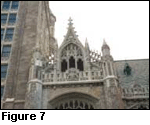 Figure 7 shows a historical building in which the ornamental masonry is cast stone. The top finial elements were removed decades ago due to structural problems caused by being too tall and slender. These elements were rebuilt during a recent building restoration using prestressing to secure them to the walls below.
Figure 7 shows a historical building in which the ornamental masonry is cast stone. The top finial elements were removed decades ago due to structural problems caused by being too tall and slender. These elements were rebuilt during a recent building restoration using prestressing to secure them to the walls below.
Prefabricated wall panels are another fertile field for prestressing. The prestressing can compensate for shipping and handling stresses, as well as the stresses in the panels once installed.
While all of the projects shown here use prestressing, it's worthy to note that none of them have any outward appearance to indicate there is anything special about their construction.
Materials
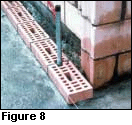 In the examples shown, prestressing is used with many types of masonry that are readily available. Most hollow core masonry (CMU or clay) will work with prestressing. A- or H-shaped concrete masonry units allow the masonry to be constructed around the tendons. Figure 8 shows a clay unit used in Switzerland. There are also proprietary systems with special shapes specifically for prestressing.
In the examples shown, prestressing is used with many types of masonry that are readily available. Most hollow core masonry (CMU or clay) will work with prestressing. A- or H-shaped concrete masonry units allow the masonry to be constructed around the tendons. Figure 8 shows a clay unit used in Switzerland. There are also proprietary systems with special shapes specifically for prestressing.
The key components to prestressed masonry are the tendons themselves. Currently the MSJC only allows steel tendons. Manufacturers such as Dur-O-Wal, Williams Form Engineering and VSL provide tendons and hardware for their systems. These products are an outgrowth of the prestressed concrete industry. Bars are more common, but full-length strands are available as well. The bars are partially or fully threaded. Tendons for use in masonry generally vary in diameter from 1/2-inch up to 3/4-inch. Each tendon is stressed to between 7,000 and 16,000 pounds ? the actual amount is determined by the design. Similar to concrete design, an allowance is made to account for the tendons losing some of their stress over time.
Some General Recommendations for Using Post-tensioning
Working with prestressed masonry does require some new skills and thinking by the contractor. Critical elements to the success of the projects include:
- Selecting a prestressing system along with the anchor types.
- Evaluating the design for suitability.
- Planning the layout of the tendons and bottom anchors.
- Setting the top anchors.
- Sequencing and tensioning the tendons.
System Selection
The choice of which prestressing system to use is based upon whether you want to use bar tendons or strands. Bars are less expensive, more readily available, and come in stock lengths. Couplers are used to connect the bar tendons together. The threaded ends must be fully engaged in the couplers. Strands are used full-length without couplers.
The tendon size is a function of the design. However, as with reinforced masonry, larger tendons at a wider spacing tend to be more economical. On the other hand, larger tendons will cause locally higher stresses, whereas using smaller tendons makes installation of each tendon easier. The decision as to which tendon size to use has to balance both concerns. The final selection is usually based upon economics.
If corrosion protection is important, strands offer the best corrosion protection because they are covered with a plastic sheath and are placed in a duct (Figure 8 shows a duct). The duct is installed with the masonry and the tendon is installed full height after the wall is constructed. Bars are usually hot-dipped galvanized or epoxy coated and left exposed in the masonry core.
Suitability of the Design
This is often a function of the layout of openings and piers, as well as the size of the building. Small, thin wall areas or piers are not suited to prestressing due to the high compression introduced by the tendons. If there are a few of these, they can be constructed using reinforced masonry. If there are several instances of these conditions, it may make any prestressing system uneconomical.
Multi-story construction must also consider the alignment of openings from floor to floor. While alignment is preferred for all masonry to avoid distributing loads over openings, for post-tensioning the offsets also add additional expenses since the tendons cannot be installed continuously. Also, there is added cost in labor and hardware to install two one-story tendons versus one two-story tendon. The left side of Figure 9 shows the effect of offset openings. The preferred alignment is shown on the right.

Tendon Layout
This is one of the most critical elements of post-tensioning construction. The actual tendon layout is dictated by the openings in the walls. The tendons must be placed away from the edges of the openings.
It is recommended to grout the edges of the openings and place the closest tendon at approximately two feet away. This does not create any special problems because it is common to grout and reinforce the jambs of openings.
Bottom Anchor Selection
The choice of which anchor is used has an impact upon constructability and placement tolerances. Three options are possible.
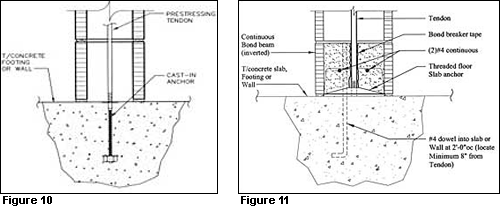
A cast-in-place anchor (Figure 10) provides the strongest and most reliable anchorage. However, installation tolerances are difficult to control and preplanning is needed during the foundation construction to determine the masonry coursing. If the foundation contractor installs these anchors, coordination with the mason contractor is essential.
A second option is the mason contractor can install an adhesive anchor as the masonry layout occurs. This reduces the concern over placement tolerances. The disadvantage to this anchor is the strength is dependent upon the quality of the adhesive and the care taken during installation. However, there are concerns over long-term creep and the fire resistance of adhesives.
The bottom anchor method (Figure 11) also gives the mason full control over installation. The anchorage does not have to be embedded in the foundation as long as it's not part of a shear or cantilever wall. It is also ideal for post-tensioning interior partitions that are braced at the top. An additional doweled connection, identical to that used in reinforced masonry and separate from the post-tensioning, will lock in the bottom of the wall.
Top Anchor Location
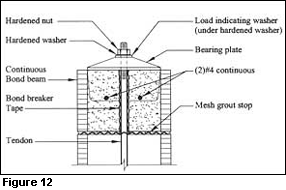 The anchor and the position of the anchor should be considered in planning a project. Figure 12 shows a design detail for new construction.
The anchor and the position of the anchor should be considered in planning a project. Figure 12 shows a design detail for new construction.
Providing accessibility to the top anchor for the future is advisable wherever possible. Usually it is not necessary for masons to go back and re-tension the tendons; however, the tendons have to be loosened prior to cutting into the walls for future renovations.
Tensioning
The tightening of the tendons is not difficult. It is done either with a wrench (Figure 13) or a small, hydraulic jack ? torque wrenches are not commonly used. Tension indicator washers are available to check the tension if a wrench is used. Figure 14 shows a feeler gauge being used to check one of these washers. Dye filled washers will be available soon to eliminate the need for the gauges. As the tendons are stressed, they stretch; their elongation must be measured to verify the full length is being tensioned.
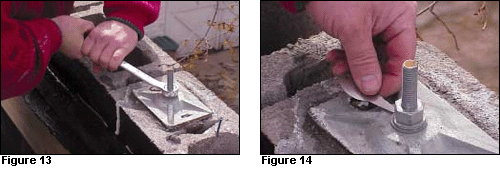
Since tendons are designed to accommodate 25 to 35 percent losses, it is usually not necessary to retighten the tendons. However, the design should specify the tensioning sequence. If none is given, each tendon is tensioned fully one at a time. However, other procedures are possible. Some engineers may require partial tensioning of all tendons followed by a final stressing. Others may require the tendons to be stressed in a patterned sequence. The intent is to eliminate some of the losses inherent in the tensioning process.
What's Coming?
Prestressed masonry is evolving quickly. This evolution is due to both new research and new material and system developments. Companies are now developing mortarless systems reinforced with post-tensioning, and new masonry units specifically made to facilitate tendon installation are currently being developed. Prefabricated walls, beams and columns are possible.
Research on the subject of prestressed masonry is also being conducted more frequently. In July 2003, the 9th North American Masonry Conference (9NAMC) dedicated an entire session on prestressed masonry.
The MSJC code will once again be updated in 2005. This update is a direct reflection of the research and experience derived over the past ten years. The combination of new research and advancements in material and system development will lead to the greater use of prestressed masonry, especially in seismic areas. One of the outgrowths of this work will be that non-metallic tendons and hardware made from composites will likely be included in the codes.
As you can see, prestressed masonry has come quite a ways over the years and there is much advancement still to come!
About the Author
David T Biggs PE, SE is a structural engineer with Biggs Consulting Engineering in Saratoga Springs, N.Y. He serves as the coordinator for the BIM-M Initiative. Biggs is an Honorary member of The Masonry Society and a Distinguished Member of ASCE.


















